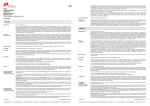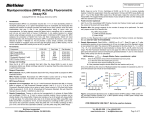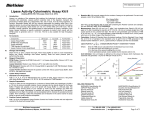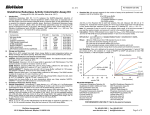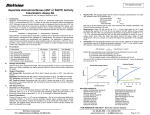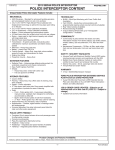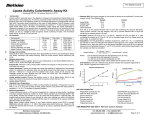Download data Sheet - BioVision
Transcript
BioVision Myeloperoxidase (MPO) Activity Colorimetric Assay Kit (Catalog #K744-100; 100 assays; Store kit at -20°C) Introduction: Myeloperoxidase (MPO) is a peroxidase (EC 1.11.1.7) abundantly expressed in neutrophils. It is a lysosomal protein stored in the azurophilic granules of the neutrophil. MPO contains a heme which causes its green color in secretions rich in neutrophils, such as pus and some forms of mucus. MPO catalyzes the production of hypochlorous acid (HClO) from hydrogen peroxide (H2O2) and chloride anion, Cl- (or halide). MPO also oxidizes tyrosine to a tyrosyl radical using hydrogen peroxide as oxidizing agent. In BioVision’s MPO Assay Kit, HClO produced from H2O2 and Cl- reacts with taurine to generate taurine chloramine, which subsequently reacts with the TNB probe to eliminate color (λ = 412 nm). The kit provides a rapid, simple, sensitive, and reliable test suitable for high throughput activity assay of MPO. This kit can be used to detect MPO as low as 0.05 mU per well. Kit Contents: Component MPO Assay Buffer DTNB Probe (100 mM) TCEP (50 mM) MPO Substrate Stop Mix MPO Positive Control (lyophilized) 100 Assays Cap Code Part Number 25 ml 50 µl 50 µl 50 µl 20 µl 1 vial WM Red Clear Blue Green Purple K744-100-1 K744-100-2 K744-100-3 K744-100-4 K744-100-5 K744-100-6 III. BioVision Incorporated 155 S. Milpitas Boulevard, Milpitas, CA 95035 USA 1 OD 412 nm Storage and Handling: Store kit at -20°C protected from light. Allow Assay Buffer to warm to room temperature before use. Briefly centrifuge small vials before opening. Read the entire protocol prior to performing the assay. IV. Reagent Preparation: TNB Reagent/Standard: TNB Reagent/Standard: TNB is easily oxidizable so it needs to be prepared from DTNB Probe as needed. Use the same day as prepared, discard any unused TNB reagent/standard. The amount of DTNB Probe for each well (standard, sample and background control) is 0.5µl. The amount per well of TCEP is 0.5 µl and of Assay Buffer is 49 µl for a total of 50 µl per well. (Example: For 10 wells, take 5 µl DTNB Probe, 5 µl TCEP and 490 µl Buffer, mix and set aside.) MPO Substrate: Aliquot and store at -20°C. Stable for 2 months. Working solution: Add 5 µl MPO Substrate to 300 µl dH2O. Make fresh and discard unused portion. Stop Mix: Add 200 µl dH2O and dissolve. Aliquot and store at -20°C. Use within two months. MPO Positive Control: Reconstitute the positive control with 100 µl MPO Assay Buffer. Aliquot and store at -20°C. Use within two months. V. MPO Assay Protocol: 1. Standard Curve Preparation: Add 150, 140, 130, 120, 110 and 100 µl of MPO Assay Buffer into a series of wells. The Standard will be added to the wells (0, 10, 20, 30, 40, 50 µl respectively) at the end of the sample incubation period (see (4) below). 2. Sample Preparation: Homogenize tissue or cells in 4 volumes of PBS having 0.1 % NP40, centrifuge (13,000g, 10 min) to remove insoluble material. Serum samples can be directly diluted in the MPO Assay Buffer. Add 1-50 µl test samples in 96 well plate. For white blood cells, take 2 ml of blood and lyse RBC using RBC Lysis Buffer (Cat # 5831). Incubate for 10 min. at room temperature. Centrifuge at 400 x g for 5 min. and remove the supernatant carefully. Wash the pellet with 1 ml 1X PBS. Centrifuge at 400 x g for 5 min, and remove the supernatant carefully. Lyse the pellet using 200 µl MPO Assay Buffer. Keep on ice for 10 min. Centrifuge at 10,000 x g for 10 min. to remove insoluble material. Collect the supernatant. Add 1-10 µl of the WBC lysate into a 96-well plate. Prepare parallel sample well(s) as background control. Adjust the volume of background control and sample wells to 50 µl/well with Assay Buffer. We suggest testing several doses of a sample to ensure the readings are within the standard curve range. 0.8 0.6 0.4 0.2 y = 0.0151x + 0.0536 0 MPO Activity (mU/mg) II. 3. Positive Control Preparation: Add 5 - 10 µl of the reconstituted MPO Positive Control to optional Positive Control well(s). Adjust the final volume 50 µl/well with MPO Assay Buffer. 4. Reaction Mix: Mix enough reagents for the number of assays to be performed. For each well, prepare a total 50 µl Reaction Mix: Reaction Mix Sample Background Control Mix 40 µl MPO Assay Buffer 40 µl MPO Assay Buffer 10 µl MPO Substrate 10 µl dH2O Add 50 µl of the Reaction Mix to each well containing the Samples & Positive Control wells. Add 50 µl of the Sample Background Control Mix to the sample background controls. Mix well. Note: DO NOT ADD REACTION MIX TO STANDARDS. Incubate at 25°C for 30 to 120 min. (record this time as T), then add 2 µl Stop Mix to all sample, Standard wells, background control & Positive Control wells and mix. Incubate another 10 min to stop the reaction & add 50 µl TNB Reagent/Standard to each of the sample, sample background control & Positive Control wells. Add 0-10-20-30-40-50 µl TNB Reagent/Standard (0-10-2030-40-50 nmol respectively) to the Standard wells at this time. We suggest running samples for 30, 60 and 120 min followed by the Stop Mix and TNB Reagent at each time point to ensure values will fall within the linear range of the Standard Curve. 5. Measurement: After 5-10 min, read at 412 nm. The Positive Controls and samples will show decreased color proportional to the amount of enzyme present, calculated as ∆A412nm = Asample background - Asample. It is recommended to use the ∆A values which are in the linear range of the Standard Curve. 6. Calculation: Subtract 0 Standard reading from all Standard readings. Plot the TNB Standard Curve. Apply the ∆A412 nm of samples to the Standard Curve to get B nmol of TNB consumed in the sample reaction during the given time. 𝐁 Sample MPO Activity = 𝐓 x 𝐕 × Sample Dilution Factor = nmol/min/ml = mU/ml Where: B = TNB amount calculated from the Standard Curve (in nmol). T = time of the first incubation (i.e., pre-Stop Mix, in min). V = pre-adjusted sample volume added into the reaction well (in ml). Unit Definition: One unit of MPO is defined as the amount of MPO which generates taurine chloramine to consume 1.0 µmol of TNB per minute at 25 °C. (c) (b) (a) 1 OD 412 nm I. For research use only rev. 2/15 0.8 0.6 0.4 0.2 0 100 80 60 40 20 0 0 10 20 30 40 50 nmol TNB Figure: (a) TNB Standard Curve. (b) Measurement of MPO activity using WBC lysate (3 µg), and MPO Positive Control (5 µl) and (10 µl). (c) MPO specific activity in WBC lysate. Assays were performed following kit protocol. VI. RELATED PRODUCTS: NAD/NADH Quantification Kit Fatty Acid Assay Kit Triglyceride Assay Kit Lipase Assay Kit Adipogenesis Assay Kit Lactate assay Kits Glycogen Assay Kit NADP/NADPH Quantification Kit Uric Acid Assay Kit Free Glycerol Assay Kit Ethanol Assay Kit Cholesterol Assay Kits Pyruvate Assay Kit Glucose Assay Kits FOR RESEARCH USE ONLY! Not to be used on humans. Tel: 408-493-1800 | Fax: 408-493-1801 www.biovision.com | [email protected] Page 1 of 2 BioVision For research use only rev. 2/15 GENERAL TROUBLESHOOTING GUIDE: Problems Cause Solution Assay not working • Use of ice-cold assay buffer • Assay buffer must be at room temperature • Omission of a step in the protocol • Refer and follow the data sheet precisely • Plate read at incorrect wavelength • Check the wavelength in the data sheet and the filter settings of the instrument • Fluorescence: Black plates (clear bottoms) ; Luminescence: White plates ; Colorimeters: Clear plates • Use of a different 96-well plate Samples with erratic readings Lower/ Higher readings in Samples and Standards Readings do not follow a linear pattern for Standard curve Unanticipated results • Use of an incompatible sample type • Refer data sheet for details about incompatible samples • Samples prepared in a different buffer • Use the assay buffer provided in the kit or refer data sheet for instructions • Cell/ tissue samples were not completely homogenized • Use Dounce homogenizer (increase the number of strokes); observe for lysis under microscope • Samples used after multiple free-thaw cycles • Aliquot and freeze samples if needed to use multiple times • Presence of interfering substance in the sample • Troubleshoot if needed • Use of old or inappropriately stored samples • Use fresh samples or store at correct temperatures until use • Improperly thawed components • Thaw all components completely and mix gently before use • Use of expired kit or improperly stored reagents • Always check the expiry date and store the components appropriately • Allowing the reagents to sit for extended times on ice • Always thaw and prepare fresh reaction mix before use • Incorrect incubation times or temperatures • Refer datasheet & verify correct incubation times and temperatures • Incorrect volumes used • Use calibrated pipettes and aliquot correctly • Use of partially thawed components • Thaw and resuspend all components before preparing the reaction mix • Pipetting errors in the standard • Avoid pipetting small volumes • Pipetting errors in the reaction mix • Prepare a master reaction mix whenever possible • Air bubbles formed in well • Pipette gently against the wall of the tubes • Standard stock is at an incorrect concentration • Always refer the dilutions in the data sheet • Calculation errors • Recheck calculations after referring the data sheet • Substituting reagents from older kits/ lots • Use fresh components from the same kit • Measured at incorrect wavelength • Check the equipment and the filter setting • Samples contain interfering substances • Troubleshoot if it interferes with the kit • Use of incompatible sample type • Refer data sheet to check if sample is compatible with the kit or optimization is needed • Sample readings above/below the linear range • Concentrate/ Dilute sample so as to be in the linear range Note: The most probable list of causes is under each problem section. Causes/ Solutions may overlap with other problems. BioVision Incorporated 155 S. Milpitas Boulevard, Milpitas, CA 95035 USA Tel: 408-493-1800 | Fax: 408-493-1801 www.biovision.com | [email protected] Page 2 of 2


